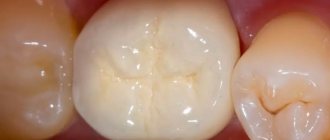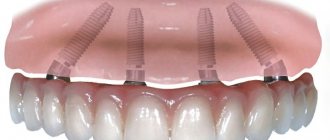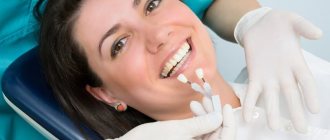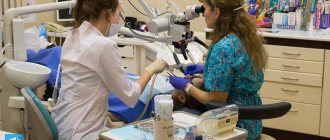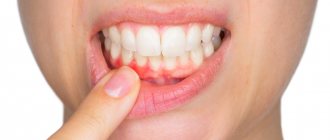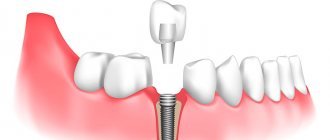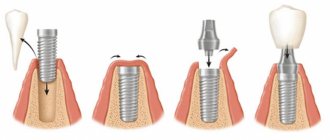You need to think about subsequent prosthetics even before tooth extraction. The first thing you should do is ask which specialist will perform the extraction. It is better to entrust this manipulation to an experienced dental surgeon, who will remove the tooth in a way that is minimally traumatic to the bone tissue. The next important question concerns timing. To find out exactly when a prosthesis can be installed after tooth extraction, you need to contact your dentist. The answer depends on how the lost unit will be replaced, as well as on the characteristics of the clinical picture.
Installation of a temporary prosthesis
After extraction, an empty area is formed in the dentition. Leaving everything as it is for a long time is extremely undesirable, since even a single adentia causes a number of unpleasant consequences. Among them:
- Displacement of adjacent teeth towards the empty space and weakening of their fixation in the sockets.
- Changes in bite, which can lead to problems with the temporomandibular joint.
- Disorders of the stomach and intestines caused by difficulty in chewing food.
- Changing the shape of the face, weakening the tone of its muscles, thinning of the lips, and the appearance of wrinkles.
So, if a tooth is removed, after what time can prosthetics be done? To prevent the problems listed above, it is advisable to act as quickly as possible. Already three to four days after extraction, you can begin to prepare for the installation of a temporary crown. Such a prosthesis will help quickly eliminate an aesthetic defect, restore chewing function, and prevent adjacent teeth from moving. You can wear it for up to a year.
What prosthetic methods are used?
All methods of prosthetics can be divided into two large groups - temporary and permanent. If short-term replacement is required, immediate prostheses are used, i.e. urgent. They can be acrylic or nylon. With their help you can replace:
- one or two dental units - a so-called “butterfly prosthesis” is installed;
- several teeth – a prosthesis in the form of a plate is installed.
The structure is fixed in the oral cavity using special hooks. However, it is important to understand that it solves the problem for a short period of time. After this, in any case, it is worth undergoing prosthetics using permanent orthodontic structures. They can be of the following types:
- Bridges are a permanent structure that is attached to previously ground adjacent teeth. A bridge can be used if 1-2 units of the dentition have been removed;
- clasp removable dentures, consisting of an arch, a base, as well as fasteners that allow the structure to be securely fixed to the supporting teeth. They are recommended to be installed if the front, lower, or one or more molars on one side of the jaw have been removed;
- plate dentures, which are removable orthodontic structures. They are able to solve the problem of not only partial, but also complete adentia. Made from silicone, acrylic, nylon.
Prosthetics with a bridge structure
If the doctor and patient plan to install a dental bridge, then after extraction you will have to wait four to six weeks. This is the average time it takes for a hole to heal. Installation, fitting, and adjustment of a prosthesis are manipulations that can easily touch, injure, and infect healing tissues. Therefore, before they begin, the hole must be completely tightened.
After complex or multiple removals, healing time may increase. You will have to wait longer for prosthetics even if alveolitis has developed - an infectious inflammation of the tissues of the socket.
Contraindications for prosthetics
The method of prosthetics is always chosen by the attending physician, taking into account many factors, including the general condition of the patient and an assessment of his psychological comfort. Among the contraindications that may cause this procedure to be postponed for some time are the following:
- various blood clotting disorders in the postoperative period or those of a chronic or temporary nature;
- first and last trimester of pregnancy;
- menstruation in women;
- presence of chronic infectious diseases;
- the presence of acute inflammatory processes;
- decreased immunity of various origins, etc.
Even ARVI can make it impossible to carry out prosthetic procedures. Before visiting the dentist, it is recommended to measure your body temperature, and if there are indicators different from the physiological norm, you should inform your doctor. Prosthetics for loose teeth
is carried out only after consultation with a doctor, since it can be difficult due to the lack of supporting teeth necessary for installing a crown. You may be asked to remove loose teeth.
Implant installation
Prosthetics on implants is recognized as the optimal way to restore the integrity of the dentition. But to use this method, you need to wait until the bone tissue is completely restored. As a rule, this takes from three to six months. The healing time depends on where the extracted tooth was located.
To perform this operation, the bone must have sufficient height and width. If hard tissue deficiency is diagnosed, bone grafting may be necessary. In this case, delayed implantation is planned, and it may take about a year before it takes place.
What happens if you don't restore a tooth?
While eating, the load is evenly distributed over the entire upper and lower row and is transferred to the bone tissue. This stimulates its trophism, ensures normal density, as well as reliable fixation of natural roots.
Single or multiple defects in a row lead to the fact that certain areas of the jaw remain without load. The slowdown in trophism provokes gradual resorption of the bone. It loses volume and becomes less dense.
Compensatory mechanisms ensure the displacement of the remaining teeth. The chewing load is distributed unevenly, which leads to protrusion and accelerated wear of the antagonists. The units move towards the defect where the bone is less dense. Due to the weakening of the ligamentous apparatus, they become mobile.
The visible results of these processes are bite defects, enamel abrasion, and changes in facial contours. Functional inferiority of a number, as well as problems with chewing food lead to chronic gastrointestinal diseases. The severity of the described changes depends on the length of life without teeth.
Atrophic processes are irreversible. It is impossible to slow them down with removable dentures. Only implantation can stop the loss of spongy bone, since it restores trophic processes in the jaw.
Prosthetics immediately after removal
Sometimes the patient is especially persistently interested in when, after tooth extraction, prosthetics can be done, because he wants to quickly and efficiently eliminate the resulting defect. In this case, the dentist may offer immediate implantation. When using this technique, the implant is immersed in the hole immediately after the tooth is removed, then a temporary crown is installed.
Simultaneous implantation cannot be done during unplanned extraction, since such an operation needs to be prepared. But if X-ray diagnostics are carried out in advance and it is established that there are no contraindications to the installation of a root substitute, then this method is quite applicable.
Alternatives
Single or segmental row defects can be eliminated using alternative methods - removable or bridge dentures. However, their use is possible only after complete tissue healing. Removable orthopedic devices do not stop bone atrophy; fixed bridges slow down the process, but do not completely eliminate it. 3-4 months after the operation, the alveolar ridge decreases, gum recession occurs, which is especially noticeable in the incisor area.
The use of removable structures is accompanied by unpleasant sensations as a result of rubbing soft tissues, and also reduces the patient’s quality of life due to restrictions on the use of solid foods.
Professional dental hygiene
Professional hygiene is necessary before tooth extraction or implantation to reduce the microbial load. In this situation, removal of all dental plaque is also necessary for the treatment of periodontitis and elimination of gum inflammation.
After professional removal of plaque and tartar, the hygienist selected products for independent oral hygiene that will most effectively remove dental plaque and prevent gum inflammation, and taught a technique for brushing teeth that does not injure the gums.
Implantation of long-extracted teeth
As mentioned earlier, prolonged absence of even one tooth can cause irreversible destruction of bone tissue. This is one of the most serious complications, due to which the implant cannot be securely fixed in the gum cavity and over time becomes loose or is completely rejected.
In this case, the part of the bone tissue that covers the implant on top will be too thin. This can lead to exposure of the top of the pin and loss of its functional properties. That is why installing an implant in place of a long-lost tooth is possible only after osteoplasty. The doctor will fill the void with a special substance, and after a few months he will make a final decision on the possibility of installing an implant.
Bone tissue augmentation can be carried out using several methods. Sinus lifting involves the use of the maxillary sinuses, the lower wall of which is slightly raised, and the resulting area is filled with bone material. Modern dentistry also uses methods of bone regeneration or osteoplasty and bone block transplantation.
previous post
After braces, teeth moved apart
next entry
Methods for restoring a lost front tooth
If a front tooth has fallen out or been removed, then aesthetics is a very important aspect. The front teeth are a smile, this is a person’s appearance. The absence of a tooth in such an aesthetically important area significantly reduces a person’s quality of life. There may be several treatment options here.
Method 1: implant installation
It’s worth saying right away that installing an implant in the area of a missing tooth will be the most reasonable and least traumatic solution to the problem. Installing an implant involves implanting a titanium tooth root into the bone and then installing a crown on it. This design has a long service life, does not affect neighboring teeth and ensures complete restoration of the function and aesthetic properties of the teeth.
Method 2: installation of a bridge
Other options for restoring a tooth lost due to various reasons may be orthopedic methods, which are bridges and removable dentures. The most important and rather significant disadvantage of bridges in the oral cavity is its traumatic nature in relation to neighboring teeth. To make a bridge structure, the doctor needs to determine the supports on which the prosthesis will be fixed. There can be 2 such supports (2 teeth on each side of the missing one) or even more. In accordance with this, each supporting tooth must be processed and prepared for a crown, which will be part of the prosthesis. In some cases, the choice of several supports (more than 2) depends on the condition of the teeth, the area of the fallen or extracted tooth and the number of missing teeth. In addition, the disadvantage of bridges is the possible deterioration of the condition of the supporting teeth after the expiration of the service life of the prosthesis. If it is necessary to replace it, the supporting teeth, as a rule, do not satisfy all the necessary requirements, as a result of which it is necessary to take more teeth as supporting teeth or change the treatment method.
Method 3: installation of a removable denture
Another treatment option is a removable denture, which replaces the missing tooth. Such a prosthesis also needs support, not with the help of crowns, but with the help of special clasps (hooks that cling to adjacent teeth). In addition to the low aesthetic properties of this prosthesis, wearing it over time causes atrophy of bone tissue in the area of the removed or fallen tooth, which can create certain difficulties if it is necessary to change the design.
Method 4: installation of pin structures and inlays
Another method of orthopedic dentistry is pin structures and inlays. These are special metal structures, on one side they have a pin that is fixed in the root of the tooth, on the other side there is a stump of the prepared tooth, and the crown is fixed on the part. With their help, you can restore a tooth if only the root remains. After treating the root and filling it, a pin-stump inlay is made, which serves as a tooth stump, onto which the crown is subsequently fixed, and the inlay pin strengthens the root and makes the final structure strong. The inlay is not visible under the crown, which gives high aesthetic properties to this treatment method. The inlays have found wide application and are successfully used by many doctors. In this case, the key role is played by the condition of the broken tooth, namely the remaining root. If the root allows the use of an inlay, then such a tooth can last for quite a long time. With such designs, the level of bone tissue is preserved, which allows for implantation after the expiration of the service life of the inlay and crown.
The most optimal way
Based on all of the above methods, in the absence of a tooth, it is better to place dental implants, since this method is the least traumatic, meets functional and aesthetic requirements, has a long service life and maintains the volume of bone tissue at the required level. Implantation is also the most optimal treatment method for complete absence of teeth. In such situations, there are several methods; in any case, implants are the most optimal solution. Several implants can support the load of the entire jaw.
Prosthetics on implants are also variable. Each patient will be able to choose the appropriate option for himself. The hygiene of structures fixed on implants is also very convenient for both the patient and the doctor. Regular visits to the dentist for preventive examinations allow you not only to maintain the proper level of hygiene, but also to monitor the dynamics of the condition of the bone tissue and the condition of the implants in the bone.
Depending on the age of the patient, various types of dental restoration are recommended, we are talking about implantation and removable prosthetics, which can be used in the case of an extremely small volume of jaw bone tissue and the impossibility of installing implants. In such cases, removable dentures are the treatment of choice for the patient. If it is possible to install at least 4 implants, then you should give preference to the surgical method!
Dial-Dent specialists who took part in this treatment
- Orthopedic dentist S.V. Zukor – diagnostics, treatment planning, preparation of treatment estimates.
- Surgeon T.R. Zhazykoev – tooth extraction under sedation.
- Anesthesiologist V.S. Kulakov – conducting sedation, monitoring the patient’s condition.
- Dentist-endodontist Yu.A. Borisova – treatment of dental canals under a microscope.
- Dental hygienist E. Smirnova – professional oral hygiene, preparation for dental treatment, selection of hygiene products, training in brushing teeth.
- Dental technician D.V. Wolf – making a temporary denture.
- Dental assistants L. Kharlamova, A. Antoshkina.
See other examples of dental treatment and prosthetics here.
Make an appointment for a consultation by phone +7-499-110-18-04 or through the form on the website. You can ask questions about dental treatment and prosthetics to the chief doctor of the clinic, Sergei Vladimirovich Tsukor, at
